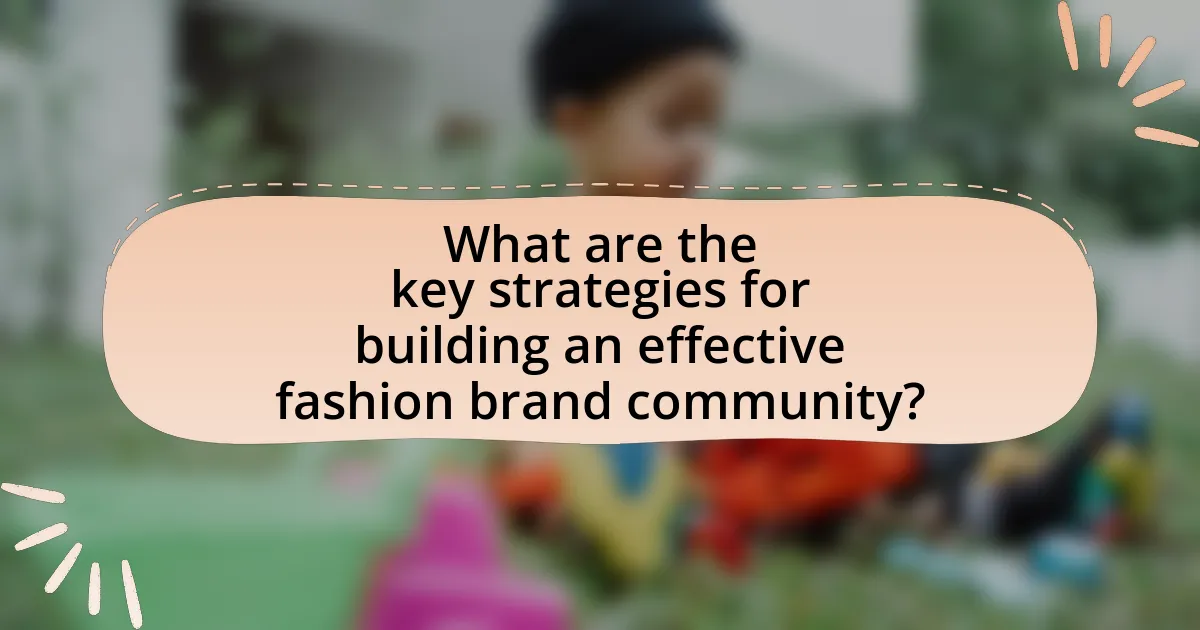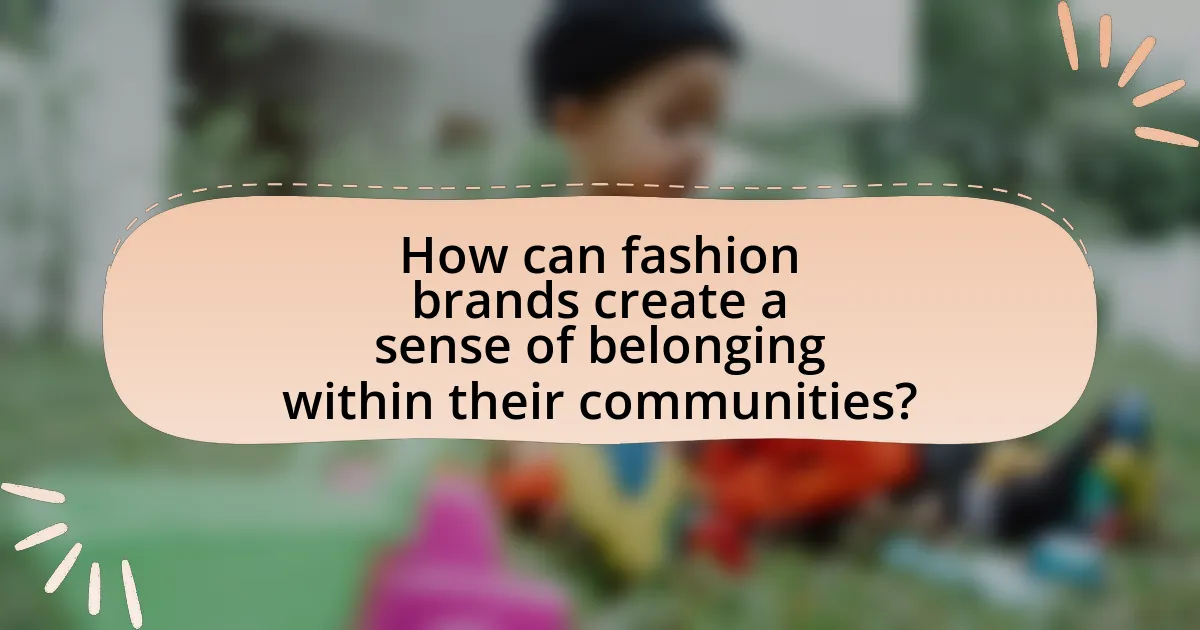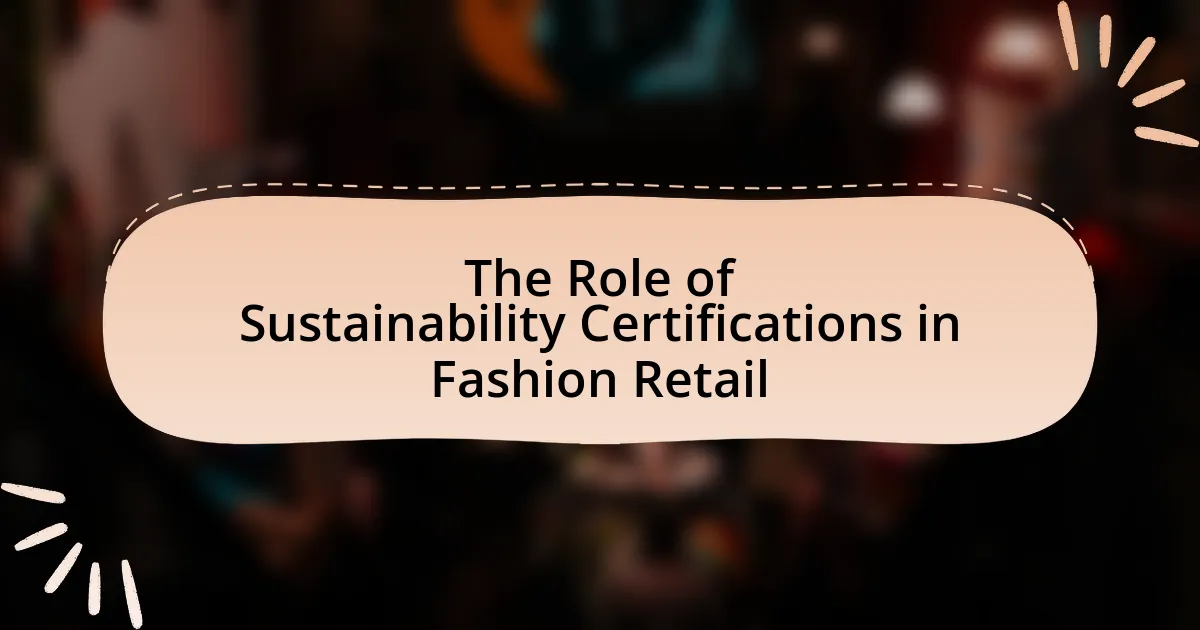The article focuses on strategies for building an effective fashion brand community, emphasizing the importance of engagement, storytelling, and social media. Key strategies include fostering customer interaction through exclusive experiences, utilizing user-generated content, and actively seeking customer feedback to enhance loyalty and advocacy. The article also highlights the role of inclusivity and diverse representation in marketing, as well as the significance of events in strengthening community ties. Additionally, it discusses methods for measuring community engagement and adapting strategies based on feedback, ultimately aiming to create a sense of belonging among consumers.

What are the key strategies for building an effective fashion brand community?
The key strategies for building an effective fashion brand community include fostering engagement, creating exclusive experiences, and leveraging social media platforms. Engaging with customers through interactive content, such as polls and Q&A sessions, enhances their connection to the brand. Exclusive experiences, like members-only events or early access to new collections, incentivize loyalty and deepen community ties. Additionally, utilizing social media platforms effectively allows brands to share user-generated content, showcase community members, and facilitate conversations, which strengthens the sense of belonging. These strategies are supported by research indicating that brands with strong community engagement see increased customer loyalty and advocacy, as highlighted in studies by the Harvard Business Review.
How can storytelling enhance community engagement in fashion brands?
Storytelling enhances community engagement in fashion brands by creating emotional connections between the brand and its audience. When fashion brands share authentic narratives about their origins, values, and the people behind their products, they foster a sense of belonging among consumers. For instance, brands like Patagonia effectively use storytelling to communicate their commitment to environmental sustainability, which resonates with their audience and encourages community involvement in related initiatives. This approach not only strengthens brand loyalty but also motivates consumers to participate in brand-related activities, thereby enhancing overall community engagement.
What elements make a compelling brand story?
A compelling brand story includes authenticity, emotional connection, relatability, and a clear narrative arc. Authenticity ensures that the brand’s values and mission resonate genuinely with the audience, fostering trust. Emotional connection engages consumers on a personal level, making them feel invested in the brand’s journey. Relatability allows consumers to see themselves in the story, enhancing their engagement and loyalty. A clear narrative arc provides structure, guiding the audience through the brand’s challenges and triumphs, which can be illustrated by successful brands like Nike, whose storytelling emphasizes perseverance and triumph over adversity. These elements collectively create a narrative that captivates and retains consumer interest, ultimately strengthening brand loyalty.
How does storytelling foster emotional connections with consumers?
Storytelling fosters emotional connections with consumers by creating relatable narratives that resonate with their experiences and values. When brands share stories that reflect the aspirations, challenges, or lifestyles of their target audience, they evoke empathy and personal identification. Research indicates that emotional engagement can increase brand loyalty; for instance, a study by the Harvard Business Review found that emotionally connected customers are more than twice as valuable as highly satisfied customers. This connection is further strengthened when storytelling incorporates authentic elements, such as real customer experiences or brand heritage, which enhance trust and relatability.
What role does social media play in community building for fashion brands?
Social media plays a crucial role in community building for fashion brands by facilitating direct engagement and interaction with consumers. This platform allows brands to create a sense of belonging among their audience through shared content, user-generated posts, and interactive features like polls and live sessions. For instance, brands like Nike and Adidas utilize Instagram to showcase customer stories and feedback, fostering a community that feels valued and heard. Research indicates that 54% of consumers prefer to engage with brands on social media, highlighting its effectiveness in building loyal communities.
Which platforms are most effective for fashion brand communities?
Social media platforms such as Instagram, Facebook, and TikTok are the most effective for fashion brand communities. Instagram, with over 1 billion monthly active users, allows brands to showcase visual content and engage with followers through stories and posts, fostering community interaction. Facebook’s groups feature enables brands to create dedicated spaces for discussions and community building, leveraging its vast user base of 2.9 billion monthly active users. TikTok, rapidly growing with over 1 billion monthly active users, offers brands a unique way to engage younger audiences through creative video content, enhancing community connection through trends and challenges. These platforms provide essential tools for engagement, visibility, and community growth in the fashion industry.
How can brands leverage user-generated content to strengthen their community?
Brands can leverage user-generated content (UGC) to strengthen their community by actively encouraging customers to share their experiences and creations related to the brand. This approach fosters a sense of belonging and engagement among community members, as it allows them to contribute to the brand narrative. For instance, brands can create campaigns that invite customers to post photos or videos using specific hashtags, which not only increases visibility but also showcases authentic customer experiences. Research indicates that 79% of people say user-generated content highly impacts their purchasing decisions, demonstrating its effectiveness in building trust and community loyalty. By featuring UGC on their platforms, brands validate their customers’ contributions, enhancing community ties and encouraging further participation.
Why is customer feedback important in developing a fashion brand community?
Customer feedback is crucial in developing a fashion brand community because it fosters engagement and loyalty among consumers. By actively listening to customer opinions and preferences, brands can tailor their offerings to meet the specific needs of their audience, thereby enhancing customer satisfaction. Research indicates that brands that incorporate customer feedback into their development processes see a 20% increase in customer retention rates, as satisfied customers are more likely to become brand advocates. This two-way communication not only strengthens the community but also drives innovation, as brands can identify trends and areas for improvement directly from their consumers.
What methods can brands use to gather and analyze customer feedback?
Brands can use surveys, social media monitoring, and customer interviews to gather and analyze customer feedback. Surveys allow brands to collect quantitative data on customer satisfaction and preferences, with tools like Google Forms or SurveyMonkey facilitating this process. Social media monitoring enables brands to track customer sentiments and opinions in real-time, using platforms like Hootsuite or Brandwatch to analyze trends and feedback. Customer interviews provide qualitative insights, allowing brands to engage directly with customers for in-depth understanding. According to a study by the Harvard Business Review, companies that actively seek customer feedback can improve their products and services, leading to a 10-15% increase in customer satisfaction.
How can feedback be used to improve community engagement?
Feedback can be used to improve community engagement by actively soliciting input from community members and implementing their suggestions. This process fosters a sense of ownership and belonging among participants, as they feel their opinions are valued and impactful. For instance, a study by the Community Tool Box found that organizations that incorporate feedback mechanisms, such as surveys or focus groups, see a 30% increase in community participation. By analyzing feedback trends, brands can tailor their initiatives to better meet the needs and preferences of their audience, ultimately enhancing engagement and loyalty.

How can fashion brands create a sense of belonging within their communities?
Fashion brands can create a sense of belonging within their communities by fostering engagement through inclusive marketing, community-driven initiatives, and personalized customer experiences. Inclusive marketing ensures that diverse voices and identities are represented, which resonates with a broader audience and encourages individuals to feel seen and valued. Community-driven initiatives, such as local events or collaborations with local artists, strengthen ties and create shared experiences among members. Personalized customer experiences, including tailored communications and loyalty programs, enhance emotional connections, making customers feel like integral parts of the brand’s journey. These strategies have been shown to increase customer loyalty and brand advocacy, as evidenced by studies indicating that brands with strong community engagement see a 20% increase in customer retention rates.
What are the best practices for fostering inclusivity in fashion brand communities?
The best practices for fostering inclusivity in fashion brand communities include actively engaging diverse voices, implementing accessible design, and promoting representation in marketing. Engaging diverse voices ensures that various perspectives are heard, which can be achieved through community forums and feedback sessions. Implementing accessible design means creating products that cater to different body types, abilities, and cultural backgrounds, thereby broadening the appeal of the brand. Promoting representation in marketing involves showcasing models and influencers from various demographics, which has been shown to resonate with a wider audience and enhance brand loyalty. For instance, a study by McKinsey & Company found that companies with diverse teams are 35% more likely to outperform their competitors, highlighting the importance of inclusivity in driving business success.
How can brands ensure diverse representation in their marketing efforts?
Brands can ensure diverse representation in their marketing efforts by actively incorporating a variety of voices and perspectives in their campaigns. This can be achieved through hiring diverse talent, including models, photographers, and creative directors from different backgrounds, which reflects the diversity of their target audience. Research shows that brands with diverse representation in advertising see a 20% increase in consumer engagement, as consumers are more likely to connect with brands that reflect their own identities. Additionally, brands should conduct regular audits of their marketing materials to assess representation and make necessary adjustments, ensuring that all demographics are accurately portrayed.
What initiatives can brands implement to promote inclusivity?
Brands can implement initiatives such as diverse hiring practices, inclusive marketing campaigns, and community engagement programs to promote inclusivity. Diverse hiring practices ensure representation across various demographics, which can lead to a workforce that reflects the brand’s customer base. Inclusive marketing campaigns that feature models of different ethnicities, body types, and abilities can resonate with a broader audience, fostering a sense of belonging. Community engagement programs, such as partnerships with local organizations that support underrepresented groups, can further enhance inclusivity by creating spaces for dialogue and collaboration. These initiatives are supported by research indicating that brands with diverse teams are 35% more likely to outperform their competitors in profitability, highlighting the business case for inclusivity.
How can brands utilize events to strengthen community ties?
Brands can utilize events to strengthen community ties by creating immersive experiences that foster engagement and connection among participants. These events, such as pop-up shops, fashion shows, or community workshops, allow brands to interact directly with their audience, facilitating personal connections and enhancing brand loyalty. For instance, a study by Eventbrite found that 95% of event attendees feel more connected to a brand after participating in an event, highlighting the effectiveness of such strategies in building community. By offering unique experiences that resonate with their target audience, brands can cultivate a sense of belonging and shared identity, ultimately reinforcing community ties.
What types of events resonate most with fashion brand communities?
Fashion brand communities resonate most with experiential events, such as fashion shows, pop-up shops, and exclusive brand launches. These events create immersive experiences that allow community members to engage directly with the brand, fostering a sense of belonging and loyalty. For instance, a study by Eventbrite found that 78% of consumers prefer to attend events that provide unique experiences, highlighting the importance of experiential engagement in building brand communities.
How can virtual events enhance community engagement?
Virtual events enhance community engagement by providing accessible platforms for interaction and participation among members. These events allow individuals from diverse geographical locations to connect, share experiences, and collaborate in real-time, fostering a sense of belonging. For instance, a study by Eventbrite found that 70% of attendees feel more connected to their community after participating in virtual events. This increased connectivity can lead to stronger relationships and loyalty within a fashion brand community, as members engage in discussions, share feedback, and participate in brand-related activities collectively.
What strategies can brands employ to maintain long-term community engagement?
Brands can maintain long-term community engagement by fostering authentic relationships, providing consistent value, and encouraging active participation. Authentic relationships are built through transparent communication and genuine interactions, which help create trust and loyalty among community members. Providing consistent value involves regularly offering relevant content, exclusive promotions, or unique experiences that resonate with the community’s interests and needs. Encouraging active participation can be achieved by creating opportunities for community members to contribute ideas, share feedback, and engage in discussions, thereby making them feel valued and integral to the brand’s mission. These strategies are supported by research indicating that brands with strong community engagement see higher customer retention rates and increased brand advocacy.
How can loyalty programs contribute to community retention?
Loyalty programs contribute to community retention by fostering a sense of belonging and rewarding consistent engagement among members. These programs incentivize repeat purchases and interactions, which strengthens the emotional connection between the brand and its community. For instance, a study by Accenture found that 77% of consumers are more likely to stay with a brand that has a loyalty program, highlighting the effectiveness of such initiatives in retaining customers. Additionally, loyalty programs often include exclusive benefits, such as early access to new products or special events, which further enhance community ties and encourage ongoing participation.
What role does consistent communication play in community sustainability?
Consistent communication is essential for community sustainability as it fosters trust, engagement, and collaboration among members. When community members are regularly informed and involved in discussions, they are more likely to participate actively and contribute to shared goals. Research indicates that communities with strong communication networks experience higher levels of member retention and satisfaction, which are critical for long-term sustainability. For instance, a study by the International Journal of Community Well-Being found that effective communication strategies significantly enhance community resilience and cohesion, leading to more sustainable practices and initiatives.

What are the challenges in building an effective fashion brand community?
Building an effective fashion brand community faces several challenges, including maintaining engagement, fostering authenticity, and managing diverse customer expectations. Engagement can wane if brands do not consistently provide value or create meaningful interactions, leading to a disconnect between the brand and its community. Authenticity is crucial; brands that fail to align their messaging with their values risk losing trust and loyalty among community members. Additionally, the fashion industry is diverse, and brands must navigate varying cultural and personal preferences, which can complicate community-building efforts. According to a study by McKinsey & Company, 75% of consumers expect brands to take a stand on social issues, highlighting the importance of aligning community values with broader societal expectations.
What common pitfalls should brands avoid when creating a community?
Brands should avoid neglecting genuine engagement when creating a community. Fostering authentic interactions is crucial, as communities thrive on meaningful connections between members and the brand. Research indicates that 70% of consumers feel more connected to brands that engage with them authentically, highlighting the importance of real dialogue over superficial interactions. Additionally, brands should steer clear of overly controlling the narrative, as this can stifle creativity and discourage participation. A study by the Community Roundtable found that communities with high member autonomy report 50% more engagement, demonstrating that allowing members to contribute freely enhances community vitality. Lastly, brands must not overlook the importance of inclusivity; failing to create an inclusive environment can alienate potential members. According to a report by McKinsey, diverse teams are 35% more likely to outperform their less diverse counterparts, underscoring the value of inclusivity in community building.
How can brands prevent disengagement among community members?
Brands can prevent disengagement among community members by fostering consistent communication and creating meaningful interactions. Engaging content, regular updates, and personalized responses help maintain interest and connection. Research indicates that brands that actively involve their community through feedback loops and collaborative initiatives see a 30% increase in member retention. Additionally, hosting events, both online and offline, strengthens relationships and encourages participation, further reducing the likelihood of disengagement.
What strategies can mitigate negative feedback or backlash?
To mitigate negative feedback or backlash, brands should implement proactive communication strategies. Engaging with the community through transparent dialogue allows brands to address concerns directly and demonstrate accountability. For instance, a study by the Harvard Business Review found that companies that respond promptly to customer complaints can improve customer satisfaction by up to 25%. Additionally, fostering a positive brand image through consistent messaging and community involvement can preemptively reduce the likelihood of backlash. Brands that actively listen to their audience and adapt based on feedback create a more resilient community, as evidenced by the success of brands like Patagonia, which emphasizes environmental responsibility and customer engagement.
How can brands measure the success of their community-building efforts?
Brands can measure the success of their community-building efforts through key performance indicators (KPIs) such as engagement rates, member growth, and sentiment analysis. Engagement rates can be tracked by monitoring interactions on social media platforms, forums, and community events, providing insight into how actively members participate. Member growth can be quantified by analyzing the increase in community membership over time, indicating the brand’s ability to attract and retain individuals. Sentiment analysis, often conducted through surveys or social listening tools, assesses the overall perception of the brand within the community, revealing how well the brand resonates with its audience. These metrics collectively provide a comprehensive view of the effectiveness of community-building initiatives.
What metrics are most relevant for assessing community engagement?
The most relevant metrics for assessing community engagement include participation rates, content interaction, sentiment analysis, and retention rates. Participation rates measure the number of individuals actively involved in community activities, such as events or discussions, indicating overall engagement levels. Content interaction, which encompasses likes, shares, comments, and other forms of engagement with community-generated content, reflects the quality of engagement and interest among members. Sentiment analysis evaluates the emotional tone of community interactions, providing insights into member satisfaction and community health. Retention rates track the percentage of members who remain active over time, highlighting the community’s ability to maintain interest and engagement. These metrics collectively offer a comprehensive view of community engagement effectiveness.
How can brands adapt their strategies based on community feedback and metrics?
Brands can adapt their strategies based on community feedback and metrics by actively analyzing customer insights and engagement data to inform decision-making. For instance, brands can utilize social media analytics to gauge customer sentiment and preferences, allowing them to refine product offerings and marketing approaches. A study by McKinsey & Company found that companies leveraging customer feedback effectively can improve customer satisfaction by up to 20%. By implementing changes based on this feedback, brands not only enhance their relevance but also foster a stronger connection with their community, ultimately driving loyalty and sales.
What practical tips can fashion brands implement to build an effective community?
Fashion brands can build an effective community by fostering engagement through social media platforms, hosting events, and creating exclusive content. Engaging with customers on platforms like Instagram and TikTok allows brands to interact directly, share user-generated content, and respond to feedback, which enhances brand loyalty. Hosting events, whether virtual or in-person, creates opportunities for customers to connect with the brand and each other, strengthening community ties. Additionally, offering exclusive content, such as behind-the-scenes looks or early access to new collections, incentivizes participation and makes community members feel valued. These strategies are supported by research indicating that brands with strong community engagement see increased customer retention and satisfaction.




